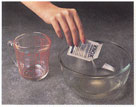|
Knox� Unflavoured Gelatine is simple and easy to work with. Depending on the nature of the recipe, you can choose one of four methods of dissolving the gelatine:
|
||||||||||||||||||||||||||||||||||||||||||||||
|
FREQUENTLY ASKED QUESTIONS MY GELATINE LUMPS
WHEN I TRY TO MIX IT WITH HOT WATER - WHAT AM I DOING WRONG? HOW DO I KNOW IF THE GELATINE IS DISSOLVED - AND WHAT'S THE BIG DEAL IF IT ISN'T ALL DISSOLVED? Follow these easy steps:
I'D LIKE TO MAKE A PRETTY GELATINE MOULD FOR A PARTY, BUT WHEN IT COMES TIME TO UNMOULD IT, I'M AFRAID I'LL BE QUIVERING MORE THAN MY MOULD. HELP? For special occasions, nothing is quite as impressive as a shimmering mould. And it's really not that hard to unmould gelatine:
If it doesn't come loose easily, simply repeat the process again. Some consumers find it easier to lightly oil the jelly mould before filling. But don't forget - you don't have to use a mould. Gelatine can be chilled in just about anything - bowls, dessert dishes, parfait glasses, baking or springform pans, graham cracker crusts, or even paper cups. HOW MANY TABLESPOONS ARE IN AN ENVELOPE? 1 pouch is about 2 1/2 teaspoons (7g) unflavoured gelatine. If a recipe calls for 1 tablespoon, use 1 pouch of unflavoured gelatine. Each pouch will gel 2 cups (500mL) of liquid and up to 1 1/2 (375mL) cups of solids. I HAVE A RECIPE THAT CALLS FOR "SHEET GELATINE". HOW MANY POUCHES OF UNFLAVOURED GELATINE SHOULD I USE? Sheets of leaf gelatine are not readily available in the United States or Canada, but it can be found in Europe. To use, these sheets are first softened in cold water for 1 to 2 minutes or until soft, then squeezed and then finally dissolved in hot liquid. One pouch of Knox� Unflavoured Gelatine has the same gelling strength as 5 sheets (2-7/8" x 8-1/2") leaf gelatine. I SOFTENED MY GELATINE ON COLD WATER, THEN ADDED IT TO THE REST OF THE INGREDIENTS. WHY DIDN'T IT GEL? Many people confuse "softening" with "dissolving". Softening gelatine in cold water or another cold liquid helps the granules swell, which is the first step in dissolving. To actually dissolve the granules, boiling liquid or heating the cold liquid in which the gelatine is softened is needed, plus some stirring. CAN I USE MY MICROWAVE OVEN TO DISSOLVE GELATINE? Yes. Gelatine can be dissolved easily in a microwave oven. Here's how: in a glass measuring cup, sprinkle 1 pouch unflavoured gelatine over 1/4 cup cold water and let stand for 1 minute. Microwave on HIGH (100%) for 30-40 seconds; stir once. WHY CAN'T I USE SOME FRESH FRUITS WITH GELATINE? Fresh figs, kiwi fruit, papaya, pineapple and prickly pears contain protease enzymes (enzymes which destroy protein). These enzymes have a softening effect on gelatine and prevent it from gelling properly. Boiling the peeled cut-up fruit for 5 minutes, however, will usually inactivate these enzymes, making all these fruits (except kiwi fruit) usable in gelatine recipes. |
Home | Brand History | The Basics | Gelatine | Recipes Contact Us | Careers | Terms & Conditions | Privacy Notice | California Supply Chain Transparency Law © Knox Gelatine
|






